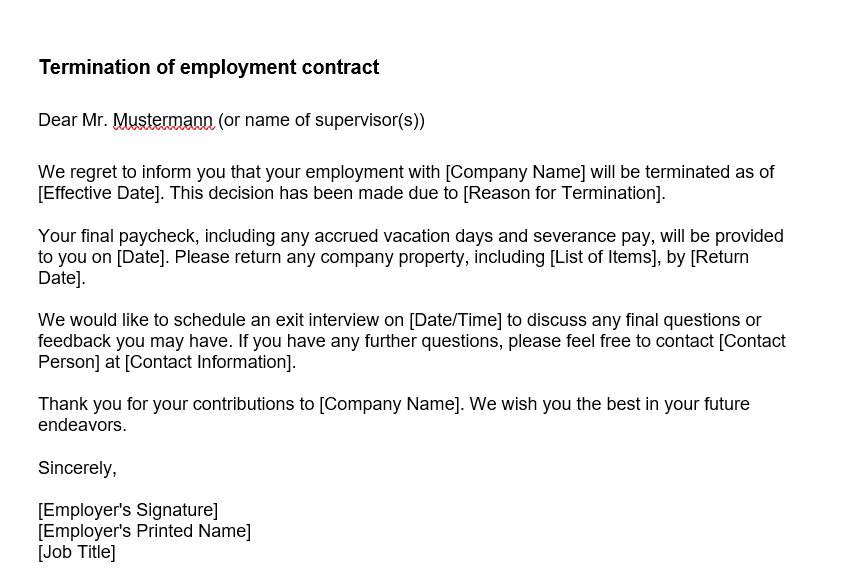Let’s face it—terminating an employee is like navigating a minefield. It’s awkward, emotional, and full of potential missteps. That’s where an employee termination letter template swoops in! This trusty tool helps You handle the tough conversations with professionalism and clarity, ensuring You tick all the right boxes without losing Your cool.
Whether You’re managing layoffs, addressing serious misconduct, or dealing with a restructuring shake-up, this guide will show You how to craft a termination letter that’s clear, legally sound, and even a bit compassionate. Because who said professional documents have to feel cold?
Full Employee Termination Letter Template – Sample

What Is an Employee Termination Letter?
An employee contract termination letter is like the professional world’s version of “we need to talk.” It’s the official notice that a working relationship is coming to an end—but with more structure, clarity, and legal oomph. This letter doesn’t just break the news; it sets the stage for a smooth exit by explaining why, when, and what’s next.

Picture it as a breakup letter, but swap out the drama for professionalism. The termination letter includes all the essentials: reasons for termination, final pay details, and a checklist for returning company items. It’s clear, concise, and leaves no room for misunderstandings. Just like a good employee termination letter template should.
Done right, this letter can help avoid legal headaches, maintain goodwill, and ensure that both You and the departing employee walk away with clarity and respect.
Why Write a Termination Letter?

Writing a termination letter isn’t just a formality. It’s like wearing armor in a battle of “he said, she said.” It gives You a crystal-clear, written record of why the employment ended and when. This helps avoid misunderstandings or the dreaded “but nobody told me!” scenario. Plus, it keeps everything professional and legally airtight, which is always a win.
A good termination letter doesn’t just inform—it communicates with compassion. Using a solid employee termination letter template, You can strike the perfect balance between being firm and fair. When done thoughtfully, this letter can even soften the blow and leave the door open for future goodwill. After all, life’s too short for unnecessary drama. Acknowledging an employee’s contributions, even at the time of exit, can reinforce a culture of appreciation. Companies that use employee recognition software ensure that positive efforts don’t go unnoticed, fostering goodwill even during difficult transitions.
How to Write an Employee Termination Letter
Start With a Polite Salutation
First impressions matter, even in tough situations. Begin with a professional yet warm salutation like “Dear [Name].” Addressing the employee directly shows respect and sets a balanced tone—formal but not robotic.
Be Clear and Concise
Don’t beat around the bush. State upfront that the employment is ending, followed by the effective date. Think of it as ripping off a Band-Aid: quick and direct. Avoid unnecessary build-up or ambiguity. Clarity helps avoid confusion and ensures everyone’s on the same page.
Explain Why
Here’s where You stick to the facts. Whether it’s due to company restructuring or a policy breach, keep the explanation short, respectful, and to the point. No need to dig into personal feelings—focus on the professional reasons and avoid anything that could sound biased.
Next Steps
Now, it’s time to tie up loose ends. Detail how and when the final pay, severance (if any), and unused benefits will be handled. Don’t forget instructions for returning company property like laptops or key cards. Everyone loves clear checklists, using a checklist maker can streamline this process. If applicable, make sure all hours worked are properly documented—timesheet templates can help standardize this process and avoid payroll hiccups.
End on a Kind Note
Finish on a thoughtful and optimistic note. If it feels right, acknowledge their contributions and wish them success in their future endeavors. Using a great employee termination letter template helps You get this balance just right. It’s a small touch, but it can make a world of difference in parting on good terms.

Legal and HR Considerations
The law loves fine print, and You should too! Before sending off that termination letter, make sure You’re up to date with local laws about notice periods, severance pay, and valid reasons for letting someone go. It’s like knowing the rules of a game before You play—it just makes everything smoother.
Document everything in your employee record management software. Think of yourself as Sherlock Holmes, but instead of a magnifying glass, you’ve got spreadsheets. The more detailed and clear, the better. When crafting the letter, keep it professional and respectful. You’re not writing a roast, after all. While you’re at it, don’t forget about final compensation and how to return company property. But hey, if you really want to show you care, consider including support services like career counseling or mental health resources. It’s a nice touch that can make a tough time just a little bit easier for the person on the other end.
Using an employee termination letter template can help You hit all these points and keep everything above board legally. It’s the perfect tool for getting everything right while staying human.
Employee Termination Letter Essentials
A good termination letter is like a well-made sandwich—simple, but it needs all the right ingredients. Here’s what to include to make sure You’re covering all the bases:
Header: Start with Your name and company details, the employee’s name, and the date. This sets the stage and ensures everything’s crystal clear.
Introduction: Briefly explain the purpose of the letter. You don’t need to sugarcoat it, but a polite and professional opening goes a long way.
Reason: Clearly state the reason for termination. Keep it neutral and avoid any emotional or loaded language—You’re a professional, not an emotional wrecking ball.
Next Steps: Outline final pay, benefits, and property return. No one likes surprises, so be upfront about what happens next.
Closure: End with a polite appreciation for their contributions and wish them well for the future. A little kindness can make all the difference.
Conclusion
Writing a termination letter can feel like walking on eggshells, but with this guide, You’ll crack the code to doing it respectfully and legally. By following these simple steps, You’ll ensure a smooth, professional process without stepping on any toes. Just remember to double-check Your letter with legal counsel and tweak it to match Your company’s tone. Ready to level up Your professional game? For more templates and additional advices on many other things like how to get professional headshots, Profile Bakery is here to help you!


